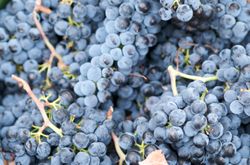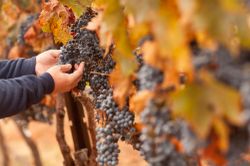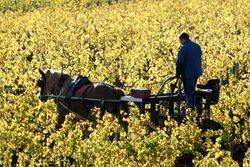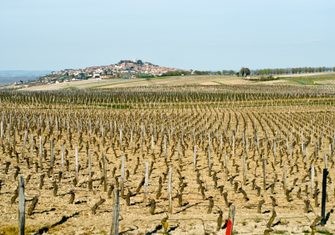France is tackling an historic drought, wildfires are raging in California, vineyards are battling dire water stress - how are the world’s changing weather patterns impacting the wine investment market and investor returns?
Wine makers are facing significant challenges caused by global rising temperatures including devastating Spring frosts, intense rainfall during the growing season creating the perfect conditions for mildew and disease, drought, golf-ball sized hail and wildfires. These freak events are becoming more common, and they are affecting vintage yields and ultimately supply in the secondary market. Wine makers are having to adapt.
The 2005 report “Climate Change and Global Wine Quality” by Dr Greg Jones, warned that the 2 degrees Celsius warming environment would make wine growing in regions such as Bordeaux “exceed a climate threshold such that the ripening of balanced fruit required for existing varieties and wines styles will become more difficult.”
As we all know, there is no quick fix to climate change, and vineyard owners are having to consider the future characteristics of their wines as some grape varietals are replaced by those that are more suited to hotter, drier conditions. There is a view that some of the increasing demand for the world’s finest wine is influenced by connoisseurs and investors wishing to ‘buy whilst they still can’ wines with the classical blend they are renowned for, as certain vintage characteristics may disappear forever.
How is Burgundy responding to climate change?
The BIVB, which represents the Burgundy wine producers, has undertaken research which shows that since 2012 there has been increasing variation in annual yields and this can be directly linked to climate change.
Laurent Delauney, co-president of the BIVB stated that “there are problems of vine degeneration, die back and vines not adapting to the changing climate, meaning the region [Burgundy] is not producing the potential volume of grapes that it could do…. We should be producing 2M hl not 1.4M hl “…. And “ we cannot continue when the potential [yield] is reducing like that.”

The 2021 frosts drove the BIVB to triple its investment into R&D into more adaptable root stocks and measures that the vineyard management can take to optimise productivity. Burgundy growers are being asked to plant a more diverse selection of vines with some wild American vines being introduced to cross-breed to build resistance to some disease.
In the most extreme scenario popular grapes such as Merlot, Cabernet and Pinot Noir could be gradually phased out. This seems unimaginable! Certainly, we can expect the migration of grapes to more northerly, cooler climes where the terroir suits.
The potential for future scarcity of Burgundy wines that already have very low levels of production has investors and collectors buying now and this trend is set to continue.
Champagne and climate change
Champagne as a region is used to acting collectively in the production of its wines and dealing with the challenges presented by climate change. The Comité Champagne began to investigate solutions to address the changing climate in the 1980s and in 2003 Champagne was the world’s first wine-growing region to calculate its carbon footprint and introduce a carbon management plan.
Innovations introduced since then address sustainable wine production, transport and freight, and building energy efficiency. One example is the 7% reduction in the weight of Champagne bottles. In one decade, the region has cut green-house gases by 15% per bottle with an aim to reduce each bottle footprint by 75% by 2050. Champagne has reduced its use of pesticides and fertilizers by 50% and aims for zero use of herbicides by 2023.

Hotter days and nights can reduce acidity and the freshness that characterises Champagne. To combat this, the region’s harvests have routinely moved forward to mid-August and this has suited some growers. Thibaut Mailloux, Director of Communications for the Comite Champagne commented that rising temperatures in Champagne has led to an increase in the number of vintage Champagnes produced.
Producers are incorporating sustainability into the core of their operations. Extensive research has shown that certain grapes are more resistant to heat, drought and damaging fungus. Hybrid grapes from the US are being selected to blend with the region’s Chardonnay grape which, the growers claim, does not impact the style or taste of Champagne.
Some of the grand marques are also producing still wines now as climate change affects growing conditions in the spiritual home of sparkling wines. Just 75,000 bottles of still wine are currently being produced, a fraction of the 300 million sparkling bottles for a global market.
Bordeaux’s battle with climate change
Bordeaux’s ocean climate has helped moderate the warming climate until recent years, when the region has suffered more violent weather events with devastating frost and hail, intense rainfall, and hot dry summers now routine.

With a vast 270,000 acres of vineyards, largely planted to just a few grape types, the region is more exposed to the effect of climate change. The great Bordeaux blends are largely dominated by Merlot, which is extremely vulnerable to the spring frosts and mildew in wetter conditions. Grapes are ripening two to three weeks earlier and rising temperatures are also creating ‘over-alcoholic’ Merlot. Cabernet Franc in St Emilion and Cabernet Sauvignon in Medoc and Graves are more resistant to climate change and both these grapes and Malbec could be increased in blends to replace Merlot to some degree.
In 2021 the authorities gave permission for four new grape types that ripen later in the summer, to be used in the region, however it’s hard to imagine these being adopted in the great investment wines. The vast majority of Bordeaux’s 5,500 growers are not as advanced as the highly resourced few estates that produce the most sought after collectable wines and these great vineyards are leading the way on the region’s innovations to deal with climate change.
The CIVB set a goal in 2020 to reduce greenhouse gases by 20% through energy savings, water reduction and renewable energy. Organic farming in the region increased by 43% that year to 49,000 acres across the region. Landscapes are being changed with increasing biodiversity. More woods, forests, hedges and wildflowers are being planted with space to introduce animals into the vineyards. Bees are being encouraged for propagation and ground cover between vines has increased.
Pauillac’s Chateau Pontet-Canet was an early leader in the organic movement in the region. St Emilion icon, Chateau Cheval Blanc started hedge planting in 2008 and a project introducing trees and wildflowers commenced in 2019. Pierre-Olivier Clouet states “We wanted to bring the soil back to life and we also wanted to create cool areas in the vineyard to reduce summer temperatures.”
A large-scale project in the Margaux appellation is planting grass corridors for pollinators and St Emilion is planting 300,000 trees and hedges along with introducing new rules to make environmental certification compulsory from 2023. Other estates have invested in techniques to capture carbon dioxide and use it including Chateaux Smith Haut Lafitte, Montrose and Guiraud.
California – the canary in the coal mine
We have watched the horrific images of California’s wild-fires’ seasons devastate people’s lives every year for some time now. Famous west coast vineyards are now set in scorched landscapes, and along with dwindling water supplies and increasing insurance costs, many wine growers in the region are questioning their future.
Yields are falling dramatically, in 2019 California sold $829million worth of red grapes, in 2020 this number fell to US$384million. The infamous Glass Fire of 2020 wiped out whole vineyards and cast smoke taint over many more. With insurance firms withdrawing wildfire cover, the California Legislature is looking at a bill to create a state-run high risk pool to provide insurance for vineyards directly impacted by climate change.
Sustainability initiatives in California are now felt to be insufficient on their own. Long established vineyards now need to adapt to the changing climate to survive. Wine growers are experimenting with ‘hot country’ grapes such as Tempranillo and Syrah into blends with Cabernet. But will they attract the palates used to the famed US Cab-Sav icons?
What might the future look like?
Scientist have concluded that a global warming of 2 degrees Celsius would result in a 56% loss in grapes worldwide. Hot countries such as Italy, Spain and Australia may struggle to prevent their losses. Cooler regions such as Germany, NZ and the Pacific north-west may become suitable for warmer varieties. Delicate, thin-skinned Pinot Noir which prefers a cooler climate could head further north and new viticultural regions could emerge. Merlot, known for its lush and velvety textures is thin-skinned and heat sensitive and becoming more challenging to grow. There could be a significant shift coming to some varietals and their fan bases.
Vineyards are investing in new initiatives to manage climate change, and it is likely that new blends will emerge, and the wine world will need to bring its consumers on the journey with them. New markets will develop, and the great wine estates and producers of the investment wines are best placed to protect and evolve the quality of their wines and be the key protagonists of the battle with climate change for this sector.
What does climate change hold for wine investors?
Fundamentally, the secondary market in fine wine and the performance of investment wines is driven by quality, supply and demand. Even in 2022 some collectors and investors are choosing to acquire the world’s most highly prized wines to guarantee their supply of their favourite fine wines comprising the classic blends they have become famous for.
Even if the great estates manage to maintain blend composition, will they be able to deliver the yields, or are the classic investment wines likely to become rarer? Owners are in a brilliant position, demand for these wines should grow going forward. In future wines will evolve, as will the market but there will never be another 2005, 2009, 2010, 2015, or 2016 vintage. Investment wines are finite and each vintage unique, that is what makes them so special.
For more information on the current performance of investment wines see our Q2 2022 Fine Wine Market Report.

